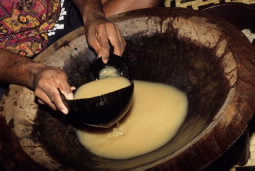FOR IMMEDIATE RELEASE
ACS News Service Weekly PressPac: July 13, 2011
The unsolved mystery of kava toxicity
“Constituents in Kava Extracts Potentially Involved in Hepatotoxicity – A Review”
Chemical Research in Toxicology
A major new review of scientific knowledge on kava — a plant used to make dietary supplements and a trendy drink with calming effects — has left unsolved the mystery of why Pacific Island people can consume it safely, while people in the United States, Europe, and other Western cultures sometimes experience toxic effects. The article appears in ACS’ journal Chemical Research in Toxicology.
Line Olsen and colleagues point out that for centuries, people of the Pacific Islands have safely consumed a beverage made from crushed kava roots. Kava’scalming effects made it popular in Western cultures in the 1990s, when people also began to use a herbal supplement for the treatment of anxiety, emotional stress and sleep problems. But in 2001, reports of liver damage among Westerners who took kava supplements gained widespread attention. Many Western countries, including the United States, the United Kingdom, and Canada, ban or regulate the sale of kava products. To determine why kava is toxic to some people but not to others, the researchers sifted through the scientific studies published on the topic.
Their review of 85 scientific studies on kava toxicity found no consensus on kava toxicity, despite several theories that have emerged over the years. Culprits include methods for preparing kava, the particular species of kava used, the possible toxicity of substances produced by the body when kava is digested and genetic differences among consumers. “To date, there remains no indisputable reason for the increased prevalence of kava-induced hepatotoxicity in Western countries,” the researchers say.
![]()

Pacific Islands can safely consume drinks made
from kava, like this traditional preparation,
while others experience toxic effects.
Contact
Science Inquiries: Michael Woods, Editor, 202-872-6293
General Inquiries: Michael Bernstein, 202-872-6042


